 W
WThe African sea catfish, also known as the marine catfish, is a species of sea catfish in the family Ariidae. It was described by Albert Günther in 1867. It is found in tropical brackish and freshwater in Tanzania, Madagascar, and the Pangani River. It reaches a maximum standard length of 45 cm (18 in).
 W
WThe Allegheny pearl dace is a species of cyprinid fish. It is demersal, freshwater fish, with a dark green back and silvery body. This species is omnivorous, consuming algae, as well as arthropods. M. margarita's range spans southern Canada and the northern United States. While not considered endangered at the federal level in the United States, several states either consider this species endangered or threatened; it faces threats of habitat destruction and invasive species.
 W
WPadogobius nigricans, the Arno goby, is a species of goby endemic to Italy. It occurs in streams, staying to well-vegetated edge areas. Males of this species reach a length of 12.5 centimetres (4.9 in) TL while the females only reach 7 centimetres (2.8 in) TL.
 W
WThe blackear wrasse is a species of wrasse, a type of fish in the family Labridae, from the warmer waters of the western Atlantic Ocean.
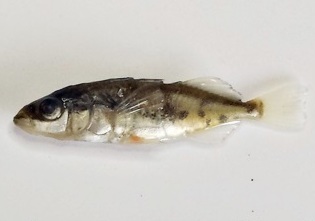 W
WThe blackspotted stickleback is a fish species, found in the western Atlantic from the coasts of Newfoundland (Canada) to Massachusetts. Brackishwater / marine benthic fish, up to 7.5 cm length.
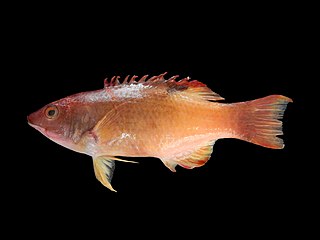 W
WBodianus neilli, the Bay of Bengal hogfish, is a species of wrasse in the family Labridae. It is found in the Indian Ocean in reefs off the coasts of the Maldives, Sri Lanka, India, Myanmar and Thailand, although records from the Maldives are doubtful. Bodianus neilli was described as Cossyphus neilli in 1867 by Francis Day with the type locality given as Madras. The specific name honours Day's friend, A.G Brisbane Neill.
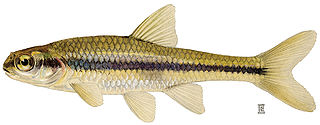 W
WThe bridle shiner is a member of the minnow family (Cyprinidae). This species has been identified as being of Special Concern by the Committee on the Status of Endangered Wildlife in Canada (COSEWIC).
 W
WThe brown mudfish a galaxiid endemic to New Zealand. The species is found in wetlands in the southwest of the North Island and the northern half of the west coast of the South Island. It commonly grows to 100–130 mm in length, and it can live to at least 7 years.
 W
WCantherhines fronticinctus, known commonly as the spectacled filefish, is a species of marine fish in the family Monacanthidae.
 W
WCentropyge multispinis, known by the common names bluefin dwarf, brown pygmy angelfish, dusky angelfish, dusky cherub, many-spined angelfish, and multispined angelfish, is a marine angelfish of the family Pomacanthidae found in tropical waters of the Indo-Pacific area.
 W
WChaetodon zanzibarensis, the Zanzibar butterflyfish, is a species of marine angelfish with a wide distribution throughout the western Indian Ocean stretching from the eastern coast of Africa to Madagascar, the Seychelles, Réunion and Mauritius.
 W
WChaetodontoplus duboulayi is a marine angelfish from Northern Australia and Southern New Guinea; with some sightings in Taiwan having been reported. It occasionally makes its way into the aquarium trade. It grows to a size of 25 cm in length.
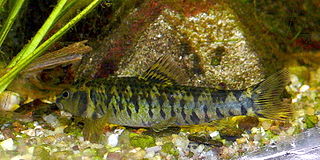 W
WCharacidium fasciatum, the darter characin, is a fish in the family Characidae.
 W
WStenogobius polyzona, the Chinestripe goby, is a species of goby native to streams and rivers on Madagascar and Réunion. Males of this species can reach a length of 15 centimetres (5.9 in) SL while females can reach 6.6 centimetres (2.6 in) SL.
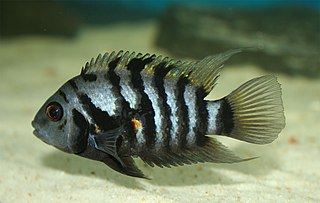 W
WThe convict cichlid is a fish species from the family Cichlidae, native to Central America, also known as the zebra cichlid. Convict cichlids are popular aquarium fish and have also been the subject of numerous studies on fish behaviour.
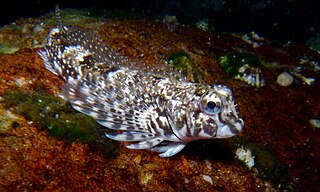 W
WLepidoblennius haplodactylus, known commonly as the eastern jumping blenny, is a species of triplefin blenny in the genus Lepidoblennius. It was described by Franz Steindachner in 1867 and is the type species of the genus Lepidoblennius.
 W
WEsomus malabaricus is a species of cyprinid endemic to Kerala in India.
 W
WThe finescale dace is a species of freshwater fish in the family Cyprinidae of order Cypriniformes. It is native to the northern portions of Minnesota.
 W
WThe fly-specked hardyhead is a species of fish in the family Atherinidae endemic and widespread in the freshwater streams of the Northern Territory down the east coast of Queensland into southern Queensland. It forms shoals in streams' shallows. It grows up to 10 cm in length.
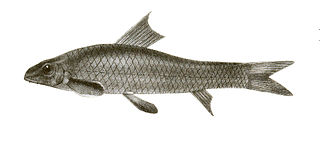 W
WGarra jerdoni is a species of ray-finned fish in the family Cyprinidae. The species is endemic to India. It is sometimes considered conspecific with Garra mcclellandi.
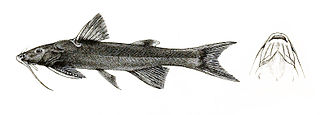 W
WGlyptothorax conirostris is a species of catfish that was first described by Steindachner, 1867. Glyptothorax conirostris is a species in genus Glyptothorax, family Sisoridae and order Siluriformes. IUCN categorise the species as insufficiently studied globally. No subspecies are listed in Catalogue of Life.
 W
WGymnallabes typus is a species of airbreathing catfish found in Benin, Cameroon and Nigeria. It occurs in the delta and the lower reaches of the Niger River as well as the Cross River. It reaches a length of 23.0 cm TL.
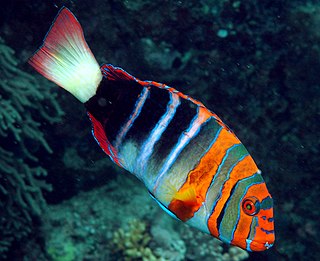 W
WThe harlequin tuskfish, Choerodon fasciatus, is a species of wrasse native to the western Pacific Ocean. It occasionally makes its way into the aquarium trade.
 W
WThe inland silverside is a neotropical silverside native to eastern North America, and introduced into California. It is a fish of estuaries and freshwater environments.
 W
WThe ironcolor shiner is a species of freshwater ray-finned fish from the family Cyprinidae, the minnows and carps. It is a widespread species in streams and rivers in eastern North America.
 W
WThe King threadfin, also known as the blind salmon, blink tassel-fish, burnett salmon, gold threadfin, king salmon, kingfish, Sheridan threadfin, triped tassel fish, or threadfin salmon, is a species of marine ray-finned fish, a threadfin from the family Polynemidae which is found in southern New Guinea and northern Australia.
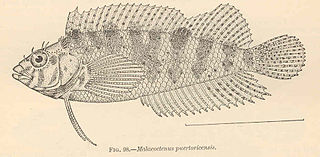 W
WMalacoctenus gilli, the dusky blenny, is a species of labrisomid blenny native to the Atlantic Ocean including the Gulf of Mexico and the Caribbean Sea from the Bahamas to the north coast of South America. This species inhabits reef patches, areas of sandy substrates with available rocks and beds of seagrass at depths of from 1 to 5 metres. It can reach a length of 7.6 centimetres (3.0 in) TL. The person honoured in the patronym of this species was not identified by Steindachner but it is most probably the American ichthyologist Theodore Nicholas Gill (1837-1914), the authority for the generic name Malacoctenus.
 W
WNeoarius graeffei, also known as the blue salmon catfish, salmon catfish, or lesser salmon catfish, is a species of catfish found in freshwater rivers of Australia and Papua New Guinea.
 W
WThe Nilgiri danio is a freshwater fish endemic to India.
 W
WThe Nilgiris barb, also called the cock fish, is a tropical species of freshwater cyprinid fish. It is native to India. It is potamodromous, benthopelagic, and less than 25 cm long.
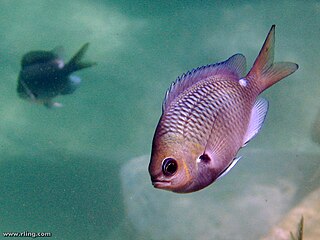 W
WThe one-spot puller or brown puller, Chromis hypsilepis, is a damselfish of the genus Chromis, found off south-east Australia and between North Cape and East Cape of the North Island of New Zealand to depths of about 60 metres, off rocky coasts. It grows to a length between 15 and 20 centimetres.
 W
WThe Pacific blue-eye is a species of fish in the subfamily Pseudomugilinae native to eastern Australia. Described by Austrian naturalist Rudolf Kner in 1866, it comprises two subspecies that have been regarded as separate species in the past and may be once again with further study. It is a common fish of rivers and estuaries along the eastern seaboard from Cape York in north Queensland to southern New South Wales, the Burdekin Gap in central-north Queensland dividing the ranges of the two subspecies.
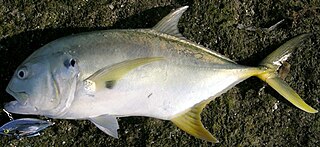 W
WThe Pacific crevalle jack is a species of large marine fish classified in the jack family Carangidae. The species is distributed through the tropical waters of the eastern Pacific Ocean from California in the north to Peru in the south, including several offshore islands. The species is best identified by its deep body and mostly unscaled breast, as well as other more detailed anatomical features. The species is known to grow to a maximum length of 101 cm and a weight of 19.7 kg. Disagreement on the status of the species has been significant in the scientific literature, with many claiming it to be conspecific with or subspecific to the Atlantic Caranx hippos. The most recent review of the crevalle jacks strongly concluded it to be a separate species based on the development of hyperostosis and fin colouring. It is predominantly a schooling inshore species, inhabiting sandy and rocky substrates, although larger individuals are occasionally found living pelagically to depths of 350 m. The Pacific crevalle jack is a fast-swimming predator, taking a variety of fish, crustaceans, and other small invertebrates. Spawning is thought to occur year-round, although peaks occur during November and May. The Pacific crevalle jack is an important species to commercial fisheries, with data available from Colima in Mexico indicating it accounts for up to 15% of the entire yearly catch. Pacific crevalle jack are highly rated gamefish, taken by both bait and a variety of lures, but are considered relatively poor quality food.
 W
WParachromis managuensis is a large species of cichlid native to freshwater habitats in Central America, where found from Honduras to Costa Rica. The scientific name refers to Lake Managua in Nicaragua from where the holotype was obtained. It is a food fish and is also found in the aquarium trade where it is variously known as the jaguar cichlid, managuense cichlid, managua cichlid, guapote tigre, Aztec cichlid, spotted guapote and jaguar guapote. In Costa Rica it is known as the guapote tigre. Males grow to a total length of 35 centimetres (14 in) and females to 30 centimetres (12 in).
 W
WParalichthys adspersus, the fine flounder, is a species of large-tooth flounder native to the eastern Pacific Ocean, along the continental shelf from the coast of Ecuador in the north to the coast of Peru in the south.
 W
WThe poor man's tropheus is a species of fish in the family Cichlidae. Until 2007 it was the only species in the genus Neetroplus, but at that time it was reclassified into the genus Hypsophrys. In 2016 it was restored to the genus Neetroplus based on genetic research by Říčan, et al.
 W
WThe popeye shiner is a North American species of freshwater cyprinid fish.
 W
WArchocentrus multispinosus also known as the rainbow cichlid is a Central American freshwater fish of the cichlid family. It is found on the Atlantic slope of Honduras, Nicaragua, and Costa Rica from Patuca River (Honduras) south to Matina River, and on the Pacific slope of Nicaragua and Costa Rica from Guasaule River south to Tempisque River. Specimens are also reported from the Choluteca River on the Pacific side of Honduras. This species is found in lakes and swamps with muddy bottoms, where it uses its specialized teeth and only 3.5% jaw protrusion to feed mostly on algae. It is commercially important as an aquarium fish. The rainbow cichlid prefers a pH range of 7.0–8.0, water hardness of 9-20 dGH and a temperature range of 21–36 °C.
 W
WThe saddled moray eel is a moray eel found in the western Atlantic Ocean. It was first named by Felipe Poey in 1867.
 W
WSalarias alboguttatus, the whitespotted blenny, is a species of combtooth blenny found in coral reefs in the Pacific Ocean and Indian Ocean. This species reaches a length of 9 centimetres (3.5 in) TL.
 W
WSchistura denisoni is a species of ray-finned fish in the stone loach genus Schistura described from the Bhavani river of Tamil Nadu.
 W
WSchistura semiarmata is a species of stone loach in the genus Schistura. It is found in the Indian states of Karnataka, Kerala, and Tamil Nadu and, at least based on some sources, in Pakistan. It grows to 5.6 cm (2.2 in) SL. It is a very common species inhabiting high altitude streams with hard bottom. It is sometimes used as an aquarium fish.
 W
WThe short-tail nurse shark, Pseudoginglymostoma brevicaudatum, is a nurse shark in the family Ginglymostomatidae, the only member of the genus Pseudoginglymostoma. It is found in the tropical western Indian Ocean between latitudes 0° and 27° S, and reaches a length of 75 cm.
 W
WThe sleepy cod is a medium-sized fish in the family Butidae, native to tropical fresh waters of northern Australia and questionably from New Guinea. It is a member of the order Perciformes, thus is unrelated to the true cods in the order Gadiformes. Neither are they closely related to the Australian freshwater cods such as the Murray cod of the family Maccullochella.
 W
WThe smooth grouper is a species of marine ray-finned fish, a grouper from the subfamily Epinephelinae which is part of the family Serranidae, which also includes the anthias and sea basses. It is associated with reefs and is found in the western Indian Ocean.
 W
WThe speckled longfin eel, Australian long-finned eel or marbled eel is one of 15 species of eel in the family Anguillidae. It has a long snake-like cylindrical body with its dorsal, tail and anal fins joined to form one long fin. It usually has a brownish green or olive green back and sides with small darker spots or blotches all over its body. Its underside is paler. It has a small gill opening on each side of its wide head, with thick lips. It is Australia's largest freshwater eel, and the female usually grows much larger than the male. It is also known as the spotted eel.
 W
WThe stargazing minnow is a North American species of freshwater cyprinid fish. It is distributed in the Green, Cumberland and Tennessee River drainages in Kentucky, Virginia, Tennessee, Georgia and Alabama.
 W
WThe tasselled wobbegong is a species of carpet shark in the family Orectolobidae and the only member of its genus. It inhabits shallow coral reefs off northern Australia, New Guinea, and adjacent islands. Reaching 1.8 m (5.9 ft) in length, this species has a broad and flattened body and head. Its most distinctive trait is a fringe of branching dermal flaps around its head, which extends onto its chin. The fringe, along with its complex color pattern of small blotches and reticulations, enable it to camouflage itself against the reef environment.
 W
WThe threadfin shad is a small pelagic fish common in rivers, large streams, and reservoirs of the Southeastern United States. Like the American gizzard shad, the threadfin shad has an elongated dorsal ray, but unlike the gizzard shad, its mouth is more terminal without a projecting upper jaw. The fins of threadfin shad often have a yellowish color, especially the caudal fin. The back is grey to blue with a dark spot on the shoulder. D. petenense is more often found in moving water, and is rarely found deep in the water column. It occurs in large schools, sometimes with gizzard shad, and can be seen on the surface at dawn and dusk. The threadfin shad may reach lengths of 8 in (200 mm), but only rarely. This fish is very sensitive to changes in temperature and dissolved oxygen, and die-offs are frequent in late summer and fall, especially when water temperature drops to 42°F. The threadfin shad is a favorite food for many game fishes, including striped bass, largemouth bass, smallmouth bass, and catfish. This fish is widely introduced throughout the United States as a forage for game fish.
 W
WThe three spot cichlid, also known as the trimac or red-eyed cichlid, is a species of cichlid from Mexico and Central America, from the subfamily Cichlasomatinae. It is a rarely found as an aquarium fish. Although still included as a highly aberrant member of Cichlasoma by FishBase, other authorities such as Catalog of Fishes have moved it to the genus Amphilophus.
 W
WTripterodon orbis, the African spadefish, is a species of spadefish native to reefs along the Indian Ocean coast of Africa. This species grows to a length of 75 centimetres (30 in) TL. This species is important to local commercial fisheries and is also popular as a game fish. This species is the only known member of its genus.
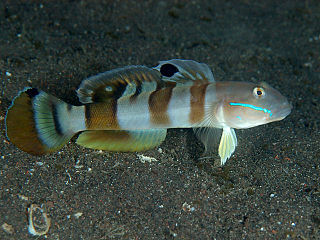 W
WValenciennea wardii, Ward's sleeper,Ward's sleeper goby, is a species of goby native to the Indian Ocean and the western Pacific Ocean in bays, reefs and lagoons at depths of from 12 to 35 metres. It can be found on sandy or silty substrates. This species can reach a length of 15 centimetres (5.9 in) SL. It can also be found in the aquarium trade. The specific name honours the United Kingdom diplomat Swinburne Ward (1830-1897) who was Her Majesty's Civil Commissioner for the Seychelles, although this species was described from specimens collected off Zanzibar.
 W
WThe Y-bar shrimpgoby is a species of goby widespread in the Indo-West-Pacific from East Africa to Melanesia and the Great Barrier Reef. This species can be found on reefs at depths of from 5 to 20 metres where they live in burrows in sandy substrates. They are commensal with alpheid shrimps. This species can reach a length of 14 centimetres (5.5 in) TL. It can also be found in the aquarium trade.
 W
WThe starry moray or yellowmouth moray is a species of marine fish in the family Muraenidae.